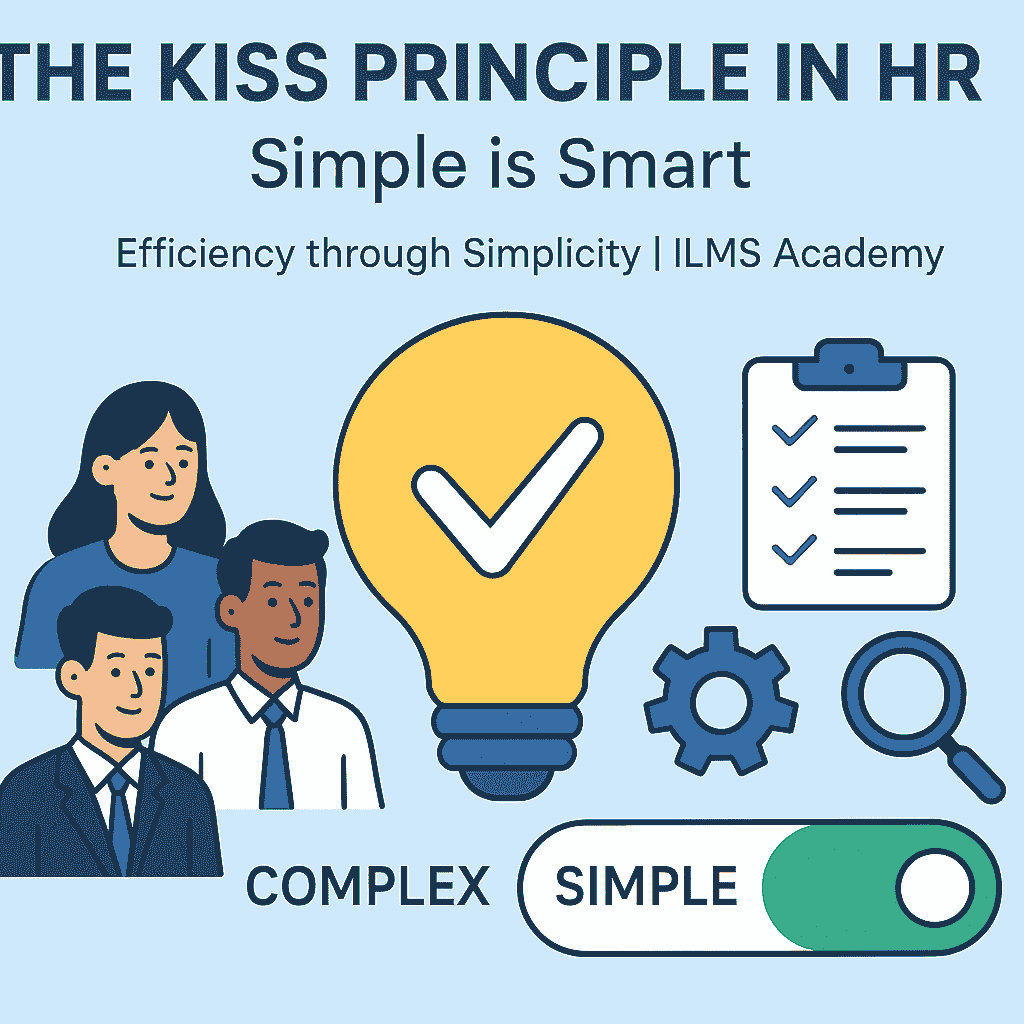The KISS Principle: Keeping HR Simple for Greater Efficiency

Table of Contents
- The KISS Principle: Keeping HR Simple for Greater Efficiency
- The Value of Simplicity in HR
- The Impact of Complexity in HR
- Examples of Applying the KISS Principle in HR
- Strategies for Implementing the KISS Principle in HR
- Corporate Case Study: Zappos’s Holacracy and Streamlined HR
- Conclusion: Simplicity as a Strategic Advantage
The KISS Principle: Keeping HR Simple for Greater Efficiency
The “KISS Principle,” or “Keep It Simple, Stupid,” is a design philosophy that holds simplicity to be the most important factor in efficiency and effectiveness. Applied to Human Resources (HR), this means simplifying policies, employee manuals, and company communication to rid them of excessive complexity and maximize clarity. HR departments can make employees better understand, decrease administrative costs, and create a more responsive and agile work environment by adopting simplicity.
The KISS Principle is not dumbing down information or cutting corners on quality; it’s about making clarity and brevity a top priority so that HR practices can be simply understood and executed. This is especially important in today’s high-speed work environment, where workers are inundated with information and want smooth experiences.
The Value of Simplicity in HR
There are a number of reasons why the advantages of simplifying HR practices exist:
-
Better Employee Understanding
- Clear and concise policies and handbooks are less confusing to employees, minimizing misinterpretations.
- This contributes to a sense of transparency and clarity.
-
Less Administrative Drudgery
- Simplified processes and forms minimize the administrative workload for HR personnel, allowing time for more strategic initiatives.
- This contributes to greater efficiency and productivity.
-
Improved Communication
- Brief and clear communication minimizes the chances of miscommunication and maximizes the chance that messages are delivered effectively.
- This creates a more open and team-oriented work culture.
-
Greater Agility
- Easy-to-modify and flexible HR practices are simpler to implement in responding to changing business requirements, allowing organizations to react quickly to business needs.
- This creates a more dynamic and responsive organization.
-
Enhanced Employee Experience
- Streamlined HR processes and communication lead to an improved employee experience, increased satisfaction, and engagement.
- This produces a better work climate.
The Impact of Complexity in HR
In contrast, complex HR practices may have some undesirable effects:
-
Employee Frustration and Confusion
- Too complicated policies and manuals confuse and frustrate employees, which results in mistakes and misunderstandings.
- This can produce low morale.
-
Administrative Costs are Higher
- More resources and time are needed to control complex processes and forms, leading to higher administrative expenses.
- This is inefficient.
-
Communication Breakdowns
- Jargon communication and complex communication can result in misinterpretations and misunderstandings, making communication ineffective.
- This causes conflict.
-
Decreased Agility and Responsiveness
- Complicated and inflexible HR practices may hamper an organization’s capacity to react to evolving business requirements, resulting in delays and lost opportunities.
- This can result in lost competitive advantage.
-
Negative Employee Experience
- Complicated and time-consuming HR processes have the potential to result in a poor employee experience, affecting satisfaction and engagement.
Examples of Applying the KISS Principle in HR
-
Employee Handbooks
- Substituting verbose and lawyer-like handbooks with simple and readable guides that highlight main policies and procedures.
- Avoid using technical language and jargon.
-
Performance Reviews
- Streamlining performance review processes by concentrating on essential performance measures and giving timely feedback.
- Reducing paperwork and bureaucratic processes.
-
Recruitment Processes
- Simplify recruitment processes through the utilization of online applications, easy interview procedures, and prompt feedback to candidates.
- Minimize the number of steps in the process.
-
Benefits Administration
- Make benefits administration easier through the utilization of online platforms, clear and concise information, and personalized assistance.
- Minimize the number of paper forms.
-
Internal Communication
- Utilize plain and simple language in all internal communications, eliminating jargon and technical language.
- Employ visual aids and multimedia to improve comprehension.
Strategies for Implementing the KISS Principle in HR
To successfully implement the KISS Principle in HR, organizations can apply a number of strategies:
-
Review Existing Practices
- Map out where HR processes can be made simpler and more streamlined.
-
Use Plain Language
- Substitute jargon and technical terms with plain language that is understandable to all employees.
-
Simplify Steps and Forms
- Simplify processes by reducing unnecessary steps and forms.
-
Take Advantage of Technology
- Utilize technology to automate processes, streamline procedures, and enhance communication.
-
Seek Employee Feedback
- Collect employee feedback on HR practices to determine where improvements can be made.
-
Train HR Staff
- Give HR staff training on simplifying procedures and communicating effectively.
-
Create Templates and Checklists
- Create templates and checklists to maintain consistency and efficiency.
-
Emphasize Key Information
- Identify the most critical information and remove irrelevant details.
Corporate Case Study: Zappos’s Holacracy and Streamlined HR
Zappos, renowned for its customer-centric approach and unique company culture, embarked on a radical organizational transformation by adopting Holacracy, a self-management system that fundamentally challenges traditional hierarchical structures. This move, driven by a desire to foster greater autonomy and agility, also led to a significant simplification of HR practices, embodying the essence of the KISS Principle.
Prior to Holacracy, Zappos, like many traditional organizations, relied on conventional management hierarchies, job titles, and performance review systems. However, as the company grew, it recognized the limitations of these structures in promoting innovation and employee engagement. The rigid hierarchies and bureaucratic processes were seen as impediments to quick decision-making and adaptability.
- Certificate Course in Labour Laws
- Certificate Course in Drafting of Pleadings
- Certificate Programme in Train The Trainer (TTT) PoSH
- Certificate course in Contract Drafting
- Certificate Course in HRM (Human Resource Management)
- Online Certificate course on RTI (English/हिंदी)
- Guide to setup Startup in India
- HR Analytics Certification Course
Furthermore, the company dismantled its traditional annual performance review system, deemed overly complex and ineffective. Instead, Zappos embraced a culture of continuous feedback and peer recognition. Employees were encouraged to provide regular feedback to one another, fostering a culture of open communication and accountability. This approach not only simplified the performance evaluation process but also aligned with the principles of self-management and continuous improvement.
The transition to Holacracy and the subsequent simplification of HR practices were not without challenges. Employees had to adapt to a new way of working, and some struggled with the increased autonomy and responsibility. However, the benefits of this radical transformation became evident over time.
The Zappos case study provides a compelling example of how the KISS Principle can be applied to HR on a large scale. By challenging traditional HR norms and embracing a self-management system, Zappos simplified its HR practices, fostering a culture of autonomy, transparency, and collaboration. This radical simplification not only improved employee engagement and innovation but also enhanced the company’s agility and responsiveness, demonstrating the strategic advantage of simplicity in a complex and dynamic business environment.
Conclusion: Simplicity as a Strategic Advantage
The KISS Principle is not merely a catchy phrase; it’s a fundamental philosophy that holds immense value for modern HR practices. In an era marked by complexity and information overload, the pursuit of simplicity becomes a strategic imperative. By streamlining policies, handbooks, and communication, HR departments can unlock a wealth of benefits, fostering a more efficient, transparent, and employee-centric work environment.
Adopting the KISS Principle translates to a tangible improvement in employee comprehension. Clear, concise language and streamlined processes eliminate confusion and frustration, allowing employees to easily navigate HR-related matters. This clarity builds trust and fosters a sense of transparency, crucial for cultivating a positive employee experience.
- Certificate Course in Labour Laws
- Certificate Course in Drafting of Pleadings
- Certificate Programme in Train The Trainer (TTT) PoSH
- Certificate course in Contract Drafting
- Certificate Course in HRM (Human Resource Management)
- Online Certificate course on RTI (English/हिंदी)
- Guide to setup Startup in India
- HR Analytics Certification Course
Furthermore, simplicity significantly reduces the administrative burden on HR staff. By eliminating unnecessary steps, forms, and jargon, HR professionals can reclaim valuable time and resources, redirecting their focus towards strategic initiatives that drive organizational growth. This efficiency translates to cost savings and increased productivity, contributing to a more agile and responsive HR function.
The impact of simplified communication cannot be overstated. By prioritizing clear and concise messaging, HR departments can minimize misunderstandings and ensure that vital information is effectively conveyed. This fosters a more collaborative and open work environment, where employees feel informed and engaged.
Ultimately, embracing the KISS Principle in HR is about creating a more human-centered and efficient workplace. By prioritizing clarity, conciseness, and simplicity, HR departments can enhance the employee experience, improve operational efficiency, and contribute to the overall success of the organization.
In a world that often favors complexity, the power of simplicity should not be underestimated. It is the key to unlocking a more effective and impactful HR landscape.
- Certificate Course in Labour Laws
- Certificate Course in Drafting of Pleadings
- Certificate Programme in Train The Trainer (TTT) PoSH
- Certificate course in Contract Drafting
- Certificate Course in HRM (Human Resource Management)
- Online Certificate course on RTI (English/हिंदी)
- Guide to setup Startup in India
- HR Analytics Certification Course
